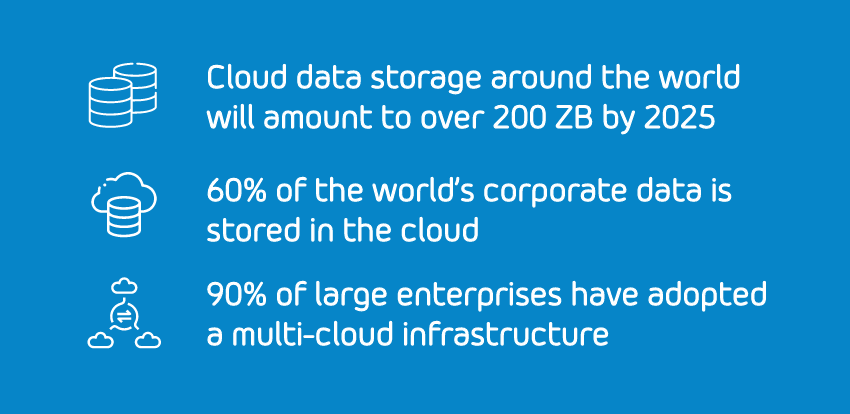
The sky’s the limit - implementing cloud integration
- 4 minute read
-
Author: Mobica
Cloud integration can deliver more than just a silver lining for savvy businesses. From opening up a world of possibilities around how data is distributed, stored and accessed, to enabling incredible potential to scale fast, the cloud revolution is well and truly here.
Here, we offer a 101 guide to cloud system integration, including factors to consider and questions to ask when planning to implement this tactic for your company.
What is cloud integration?
Cloud integration is the act of bringing together data used by disparate systems into one, single platform. By connecting applications, systems, repositories and IT environments, organisations can take advantage of real-time data and processes.
Cloud integration can encompass both deployments that are fully in the cloud or those with a hybrid model, covering both the cloud and on-site services, which will typically be legacy systems.
Head in the clouds?
Here are some awe-inspiring stats around cloud adoption to bring you back down to earth.

What’s driving demand for cloud integration?
The rise of big data has provided unprecedented possibilities for powerful customer and business intelligence.
Many companies will use a combination of SaaS applications, cloud platforms and on-site services, which adds complexity around how to realise the true value of data. Whether it’s for integrating resources to improve the customer experience as part of real-time applications and services, advancing automation capabilities, or improving your operations so that you can react faster to changes and grow as a business, all these requirements are driving demand for cloud integration.
In addition, the Covid-19 pandemic saw many major industries move to remote working, which has increased demand for cloud infrastructure services.
Yet these demands have brought about their own set of challenges, too. Following the push to cloud, critical data is now siloed across a range of cloud environments. This has created substantial barriers when it comes to organisations accessing and using this data to drive their business forward.

Preventing data silos in a multi-cloud environment can be tough, but there are several strategies you can employ to ensure data is properly shared and managed,
1. Centralised data management
By storing and managing data in a single repository that can be accessed by all cloud services, you can guarantee data consistency across different cloud environments. This can be achieved with either a centralised data lake or data warehouse, providing a single source of truth for all your data.
2. Interoperability
Ensure different cloud environments can communicate with each other. This can be achieved through the use of common data formats and APIs, allowing data to be easily transferred and processed between different cloud services.
3. Data migration
When changing data’s location, format or application, and moving it between different cloud environments, it’s critical to ensure data is properly mapped and transformed for consistency and accuracy. Various data migration tools can help with this, automating this process so it can be undertaken with confidence.
4. Governance and security
Data governance and security should be a key consideration when working with multiple cloud environments. It’s essential to implement strong data protection procedures and policies - encryption, access controls and auditing can all play their part in making sure sensitive data is properly protected and controlled.
By adopting this approach, you can be sure data is properly shared and managed across multi-cloud environments, putting a stop to data silos while promoting data consistency and accuracy.

What are the key benefits of cloud integration?
Enhance operational efficiencies
Eliminate data silos
Reduce data redundancy
Increase flexibility and scalability
Lower operational costs while increasing revenue
Improve customer satisfaction, service and support
Achieve a real competitive advantage
What do I need to consider when planning for cloud integration?
This is a difficult question to answer, because every organisation will have its own needs and objectives.
For instance, there are parts of your infrastructure that you may want connected to on-site services, such as an access control system, so that this remains operational even when the Internet fails. Otherwise, everyday data that’s required to perform your day-to-day duties will likely go to public clouds - providing the right security protocols are in place.
Public clouds can pose some risks, such as shared access, a lack of control over data, letting workers use their own smart devices, exploitable remote work related vulnerabilities, and data losses due to connection failures and downtime. However, these can be mitigated with a thorough risk assessment and by ensuring your cloud environment is properly configured.
It’s worth nothing that one particular threat to be aware of is the risk of vendor lock-ins. This means you have no choice but to continue using a vendor’s services, because changing is simply not practical. It can be difficult to move databases once they’re set-up, particularly in a cloud migration. For this reason, it’s essential to assess cloud services carefully, ensure data can be moved easily, and you may want to consider keeping internal backups of all data. Furthermore, a multi-cloud approach can overcome this barrier, by minimising your dependence on a single vendor.

When plotting a path for cloud integration, key questions to ask include:
- What strategic value are we looking to achieve with cloud integration?
- As a result of cloud integration, how will security protocols and audit policies be affected?
- What steps are we taking to reduce network latency?
- Which architecture is best suited to our organisation?
- How will we guarantee data governance?
- Can our cloud integration solution be pre-built or does it need to be completely customised?
Regardless, this scheme of work will require careful planning. Collaborating with a trusted partner can help minimise risks and ensure you have an authoritative voice, guiding you through every step of the way.
How can Mobica help with cloud integration?
From bringing together multiple cloud environments and managing cloud risk and compliance, to recommending the right cloud architecture and planning integration so that downtime is minimised, Mobica has the expertise and experience to assist with your cloud integration scheme.
Looking to get started? Get in touch and we’ll help you realise the extraordinary potential that cloud integration can unlock.
1 The Tech Trend, ‘How much data is produced every day in 2022’, https://the-tech-trend.com/reviews/how- much-data-is-produced-every-day/
2 Statista, ‘Share of corporate data stored in the cloud in organisations worldwide from 2015 to 2022’, https://www.statista.com/statistics/1062879/worldwide-cloud-storage-of-corporate-data/
3 Forbes, ‘90% of companies have a multi-cloud destiny: can conventional analytics keep up?’, https://www.forbes.com/sites/googlecloud/2022/03/04/90-of-companies-have-a-multicloud-destiny-can- conventional-analytics-keep-up/
4 Gartner, ‘Gartner Says More Than Half of Enterprise IT Spending in Key Market Segments Will Shift to the Cloud by 2025’, https://www.gartner.com/en/newsroom/press-releases/2022-02-09-gartner-says-more-than- half-of-enterprise-it-spending